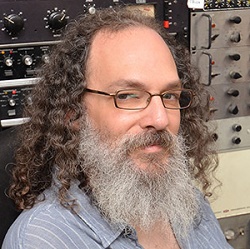
Andrew Scheps’ engineering and mixing credits read like a who’s who of popular music. He mixed four tracks on Adele’s Grammy-winning album, 21, and engineered and mixed 11 songs on the latest Red Hot Chili Peppers album, I’m with You.
The latter was one of his many collaborations with production legend Rick Rubin. Scheps has also worked with Jay-Z, U2, Justin Timberlake, Green Day, Metallica, and many others. As a producer, Scheps’ credits include bands such as Favez, The Duke Spirit, and Audrye Sessions.
Scheps owns a UAD-2 card, and uses a range of UAD-2 Powered plug-ins. He also owns a Satellite Quad for his laptop, which he takes on the road and occasionally utilizes to supplement the card in his studio computer. “Universal Audio’s stuff is definitely a big part of everything I do,” he says.
UA: What percentage of your work is producing as opposed to just tracking or mixing?
Probably a little less than half of my work is producing. But whenever I’m producing, I’m also recording and mixing. For the kinds of records I produce, nobody ever has the budget to hire separate people, which is fine with me. I enjoy doing it, but would be great at some point to be able to have someone else to take the pressure off. When I produce bands like The Duke Spirit, Favez, and acts like that, I do everything. Otherwise I either record and mix, or just mix. For example, I just mixed the Hives record that they produced themselves, which was a lot of fun; a really good record!
UA: You’ve worked with the Chili Peppers a lot. What are they like in the studio?
AS: They are some of the best players I’ve ever worked with, and they track as a band. They will do plenty of overdubs, and things like that, but when they’re tracking, everybody’s playing and Anthony [Kiedis] is singing. And it’s great, because that way you know what you’ve got — they’re not just going for drums. And they may replace stuff, or they may not, but they absolutely play. And they’re one of the best-playing bands around, they’re amazing.
“I’m constantly trying to find the balance where the arrangement and the performance start to pop out of the mix by themselves, instead of me trying to make them pop out.”
UA: Do the vocals done during those live passes ever get kept, at least in part?
AS: The lyrics aren’t necessarily finished [when they’re tracking], and the melodies are sort of in place. But there are definitely times where some of Anthony’s ad libs will stay all the way through and make it onto the record. Because he’s such a creative singer, and in the moment, stuff just comes out. So a lot of the wordless ad libs that are so great about his vocals can come from live takes, absolutely.
UA: Is there a particular mic that you like to use on his voice?
We use a Shure SM7. We’ve tried lots and lots of different microphones. He sounds really good on a lot of them, but an SM7 just sounds like the Chili Peppers.
UA: Talk about the mixing you did on Adele’s 21.
AS: I originally mixed seven tracks, but only four of them made it onto the record, I think they’ve used a couple more for B-sides or for when different territories get extra songs. On that project, I probably had to do the least amount of processing I’ve ever done—and this includes the band tracks, not just her vocals. There was one mix where I think I only had five EQs in, total, a little bit of spring reverb, and a compressor across the bus, and that was it. It was just the sound of the tracks—it was very well recorded. Greg Fidelman recorded it, and did a great job. And the band was great, and it was all live. I don’t know how much of the live vocal they kept. But she’s so good that huge portions of the vocals on the album could have been live.
UA: Do you generally work on a console?
AS: Yes, a double Neve 8068 with flying faders. I usually don’t turn the automation on until very late in the game, so I’m always looking at the faders. And also I try to generally always mix live stuff; my favorite thing is to mix bands. So I’m constantly trying to find the balance where the arrangement and the performance start to pop out of the mix by themselves, instead of me trying to make them pop out. Because at some point, the band decided that this was the take that they were going to keep. So I try to keep that feel but make it sound like a record.
UA: Why do you wait to put the automation on?
AS: What I generally do is refine the sounds while I’m trying to find that balance where it will play itself.
UA: Explain.
AS: Usually you can find a balance, where all of a sudden everything falls into place and it’s super exciting. If I have the automation on, it’s very difficult for me to rebalance. So the faders all come up as I’m working on the tones, and I get a balance. And if it’s not working, I pull all the faders down and then start rebalancing. I may start with a different instrument or whatever, now that I know the tracks a little bit better. And that will usually happen four or five times, where the faders all come down, and then I start balancing from scratch again. Of course, each time I do it, I’m starting with the tones much closer to how they’re going to end up because I’m working on that the whole time.
















